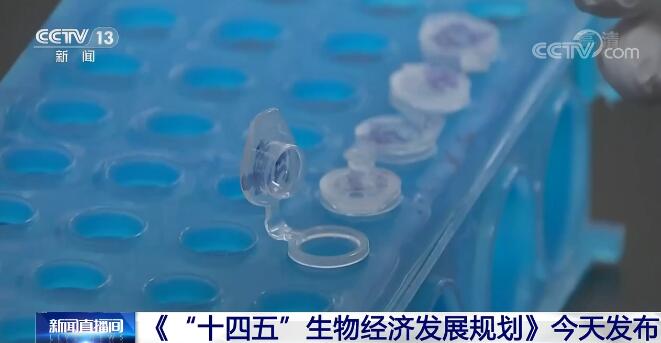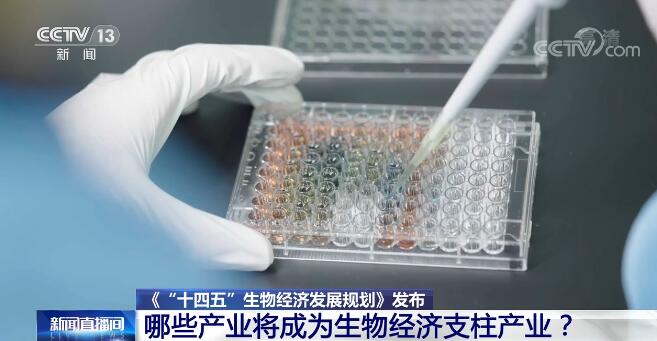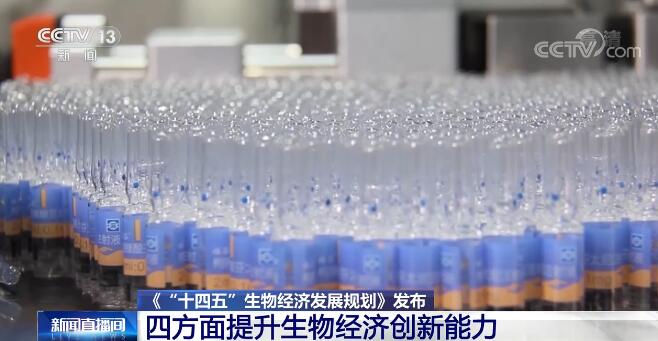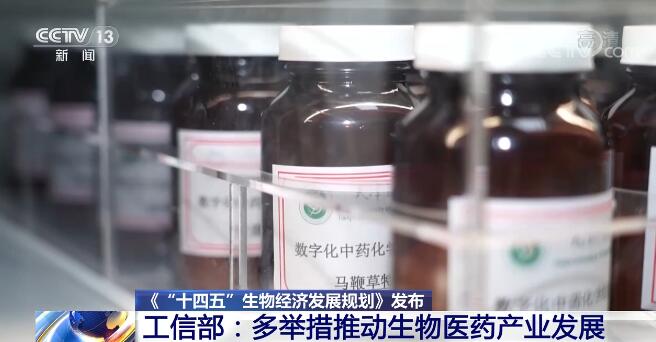The Tenth Five-Year Plan for Bio-economic Development was released | Focus on the higher-level needs in the fields of medicine, food, beauty and safety.
CCTV News:Today (May 10th), the National Development and Reform Commission released the first five-year plan of bio-economy in China, "The Development Plan of Bio-economy in the 14th Five-Year Plan", which clearly defined what bio-economy is and its development goals and tasks.
According to reports, bio-economy is an economic form with the development and progress of life science and biotechnology as the driving force, the protection, development and utilization of biological resources as the basis, and the extensive and in-depth integration of industries such as medicine, health, agriculture, forestry, energy and environmental protection.

Wang Xiang, Deputy Director of High-tech Department of National Development and Reform Commission:Focusing on the higher-level needs of the people in the fields of "medicine", "food", "beauty" and "safety", it is proposed to develop four key development areas, namely, biomedicine, bio-agriculture, biomass substitution and bio-safety, as well as seven major projects, such as improving innovation ability, benefiting the people with biomedical technology, upgrading modern seed industry, demonstrating bio-energy and environmental protection industry, integrating and applying biotechnology and information technology, preserving and developing bio-resources, and building a bio-economic pilot zone.

During the "Fourteenth Five-Year Plan" period, China will develop bio-economy from five aspects: vigorously consolidating the foundation of bio-economic innovation and cultivating and expanding the pillar industries of bio-economy. By 2025, China’s total bio-economic scale will reach a new level, and the number of enterprises with annual operating income of more than 10 billion yuan will increase significantly. At the same time, biotechnology and bio-industry benefit people’s health, food security, energy security, rural revitalization and green development more widely. In addition, it is necessary to basically build a biosafety risk prevention and control and governance system.
Bio-economy involves a wide range and covers many industrial fields. In order to highlight the key points, the Plan deploys the pillar industries of bio-economy to be cultivated from four aspects: biomedicine, bio-breeding, bio-energy and bio-information.
These four aspects are as follows: firstly, we should accelerate the empowerment of health industry by biotechnology. Promote the deep integration of advanced technologies such as genetic testing and biological inheritance with disease prevention, and improve the clinical medical level. Secondly, we should speed up biological breeding technology to empower bio-agricultural industry. We will develop biological breeding technologies such as gene editing in an orderly manner, improve the production capacity and quality of important agricultural products such as grain, and improve agricultural production efficiency. In accelerating bio-manufacturing technology to empower bio-energy and bio-environmental protection industries, we should develop high-performance bio-environmental protection materials and biological agents to promote the transformation of fossil energy into green and low-carbon renewable energy. At the same time, we must accelerate the information technology to empower the bio-information industry.

Wang Xiang, Deputy Director of High-tech Department of National Development and Reform Commission:Relying on artificial intelligence technology, biomedicine and health big data resources, develop intelligent decision-making cognitive models and algorithms to assist personalized new drug research and development; Use cutting-edge technologies such as 5G, blockchain and Internet of Things to realize the life cycle management of drugs and vaccines from production to use; Deepen the application of health big data in medical research, education and training, clinical diagnosis and treatment, product research and development, industry governance, and medical insurance payment.
The "Tenth Five-Year Plan" for the development of bio-economy puts forward that "persisting in innovation drive" should be the first of the five principles for the development of bio-economy in the "Tenth Five-Year Plan", and the innovation ability of bio-economy should be promoted from four aspects.
The Plan adheres to the problem orientation and promotes the bio-economic innovation ability from four aspects. First, speed up the improvement of biotechnology innovation ability. Focus on key areas to implement major national science and technology projects and key R&D plans, deploy leading major national science and technology infrastructure in advance, and build a national strategic scientific and technological force in the biological field. The second is to cultivate innovative subjects with strong competitiveness. Strengthen the main body of enterprise innovation, give play to the leading and supporting role of leading enterprises, cultivate individual champions in subdivided fields, and support leading enterprises to take the lead in setting up innovation consortia.

Wang Xiang, Deputy Director of High-tech Department of National Development and Reform Commission:We will strengthen new innovative forces, support the establishment of production-use consortia, accelerate the construction of research hospitals, clinical medical research centers and translational medical research centers, and encourage the construction of industry research institutes and innovation and development alliances.
The third is to optimize the regional layout of innovation and development. Guide innovative resources to gather in key areas, implement special promotion actions for key industries, and try reform measures first to create a bio-economic innovation pole and a bio-industry innovation highland. Promote the development of the national bio-industrial base in the direction of high-end, internationalization and platform. The fourth is to deepen cooperation in bio-economic innovation. Encourage domestic scientific research institutions to initiate and participate in international science projects, encourage enterprises to accelerate their integration into the international market, and promote key products to go abroad.
The relevant person in charge of the Ministry of Industry and Information Technology said that as an important part of bio-economy, biomedical industry is not only a strategic emerging industry related to the national economy, people’s livelihood and national security, but also an important foundation for building a healthy China. China will promote the high-quality development of biomedical industry by accelerating the development of cutting-edge technologies and strengthening key technologies.

In accelerating the development of cutting-edge technology, we should encourage the deep integration of Industry-University-Research doctors and promote the research and development and industrialization of a number of new drugs and new medical devices.
In strengthening core technology research, we will further develop and apply advanced manufacturing technologies and equipment, enhance key core competitiveness, improve total factor production efficiency, and continuously strengthen the advantages of large-scale and systematic manufacturing.
In improving the innovative service system, support pharmaceutical enterprises to strengthen cooperation with national laboratories, scientific research institutions and other institutions, and promote the orderly convergence and coordinated development of results transformation.
In addition, to enhance the competitiveness of pharmaceutical enterprises, it is necessary to form a number of large pharmaceutical companies, and at the same time support the development of "little giant" enterprises that focus on segmentation.
Zhou Jian, Deputy Director of Consumer Goods Industry Department of Ministry of Industry and Information Technology:We will implement the cultivation project of pharmaceutical leading enterprises, support large enterprises to implement innovation and transformation, enhance market competitiveness and sustainable development ability, and form a number of large pharmaceutical companies with high degree of internationalization and global layout development in combination with the implementation of policies such as consistency evaluation of generic drugs and quantity procurement.